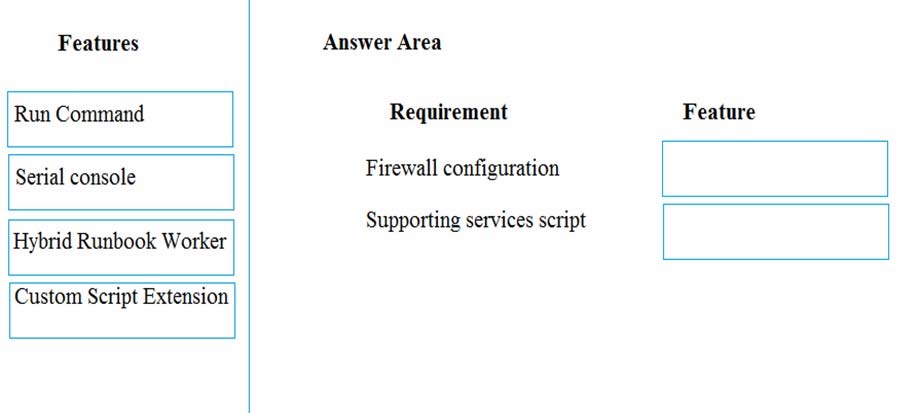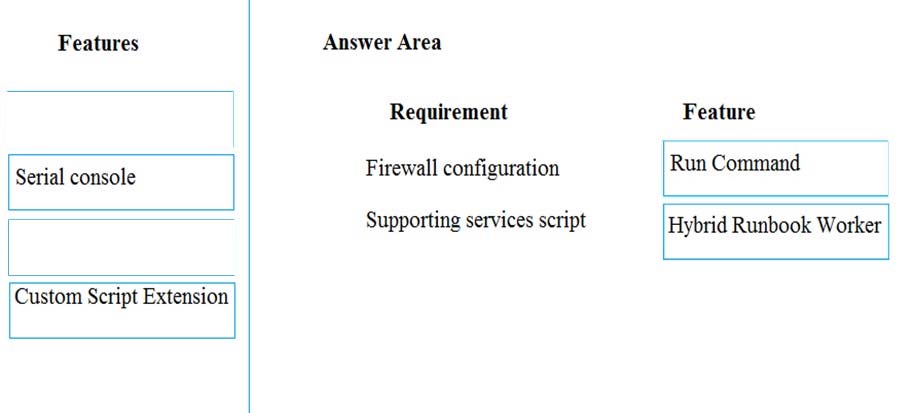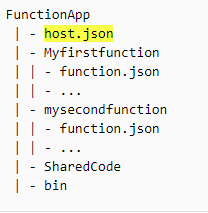Microsoft AZ-203 Exam Practice Questions (P. 3)
- Full Access (150 questions)
- One Year of Premium Access
- Access to one million comments
- Seamless ChatGPT Integration
- Ability to download PDF files
- Anki Flashcard files for revision
- No Captcha & No AdSense
- Advanced Exam Configuration
Question #11
DRAG DROP -
You are preparing to deploy an Azure virtual machine (VM)-based application. The VMs that run the application have the following requirements:
✑ When a VM is provisioned the firewall must be automatically configured before it can access Azure resources
✑ Supporting services must be installed by using an Azure PowerShell script that is stored in Azure Storage
You need to ensure that the requirements are met.
Which features should you use? To answer, drag the appropriate features to the correct requirements. Each feature may be used once, more than once, or not at all. You may need to drag the split bar between panes or scroll to view content.
NOTE: Each correct selection is worth one point.
Select and Place:

You are preparing to deploy an Azure virtual machine (VM)-based application. The VMs that run the application have the following requirements:
✑ When a VM is provisioned the firewall must be automatically configured before it can access Azure resources
✑ Supporting services must be installed by using an Azure PowerShell script that is stored in Azure Storage
You need to ensure that the requirements are met.
Which features should you use? To answer, drag the appropriate features to the correct requirements. Each feature may be used once, more than once, or not at all. You may need to drag the split bar between panes or scroll to view content.
NOTE: Each correct selection is worth one point.
Select and Place:

Correct Answer:

References:
https://docs.microsoft.com/en-us/azure/automation/automation-hybrid-runbook-worker https://docs.microsoft.com/en-us/azure/virtual-machines/windows/run-command

References:
https://docs.microsoft.com/en-us/azure/automation/automation-hybrid-runbook-worker https://docs.microsoft.com/en-us/azure/virtual-machines/windows/run-command
send
light_mode
delete
Question #12
DRAG DROP -
Fourth Coffee has an ASP.NET Core web app that runs in Docker. The app is mapped to the www.fourthcoffee.com domain.
Fourth Coffee is migrating this application to Azure.
You need to provision an App Service Web App to host this docker image and map the custom domain to the App Service web app.
A resource group named FourthCoffeePublicWebResourceGroup has been created in the WestUS region that contains an App Service Plan named
AppServiceLinuxDockerPlan.
Which order should the CLI commands be used to develop the solution? To answer, move all of the Azure CLI command from the list of commands to the answer area and arrange them in the correct order.
Select and Place:
Fourth Coffee has an ASP.NET Core web app that runs in Docker. The app is mapped to the www.fourthcoffee.com domain.
Fourth Coffee is migrating this application to Azure.
You need to provision an App Service Web App to host this docker image and map the custom domain to the App Service web app.
A resource group named FourthCoffeePublicWebResourceGroup has been created in the WestUS region that contains an App Service Plan named
AppServiceLinuxDockerPlan.
Which order should the CLI commands be used to develop the solution? To answer, move all of the Azure CLI command from the list of commands to the answer area and arrange them in the correct order.
Select and Place:
Correct Answer:
Explanation
Step 1: #bin/bash -
The appName is used when the webapp-name is created in step 2.
Step 2: az webapp config hostname add
The webapp-name is used when the webapp is created in step 3.
Step 3: az webapp create -
Create a web app. In the Cloud Shell, create a web app in the myAppServicePlan App Service plan with the az webapp create command.
Step : az webapp confing container set
In Create a web app, you specified an image on Docker Hub in the az webapp create command. This is good enough for a public image. To use a private image, you need to configure your Docker account ID and password in your Azure web app.
In the Cloud Shell, follow the az webapp create command with az webapp config container set.
References:
https://docs.microsoft.com/en-us/azure/app-service/containers/tutorial-custom-docker-image
Explanation
Step 1: #bin/bash -
The appName is used when the webapp-name is created in step 2.
Step 2: az webapp config hostname add
The webapp-name is used when the webapp is created in step 3.
Step 3: az webapp create -
Create a web app. In the Cloud Shell, create a web app in the myAppServicePlan App Service plan with the az webapp create command.
Step : az webapp confing container set
In Create a web app, you specified an image on Docker Hub in the az webapp create command. This is good enough for a public image. To use a private image, you need to configure your Docker account ID and password in your Azure web app.
In the Cloud Shell, follow the az webapp create command with az webapp config container set.
References:
https://docs.microsoft.com/en-us/azure/app-service/containers/tutorial-custom-docker-image
send
light_mode
delete
Question #13
You develop a serverless application using several Azure Functions. These functions connect to data from within the code.
You want to configure tracing for an Azure Function App project.
You need to change configuration settings in the host.json file.
Which tool should you use?
You want to configure tracing for an Azure Function App project.
You need to change configuration settings in the host.json file.
Which tool should you use?
- AVisual Studio
- BAzure portal
- CAzure PowerShell
- DAzure Functions Core Tools (Azure CLI)
Correct Answer:
B
The function editor built into the Azure portal lets you update the function.json file and the code file for a function. The host.json file, which contains some runtime- specific configurations, is in the root folder of the function app.

References:
https://docs.microsoft.com/en-us/azure/azure-functions/functions-reference#fileupdate
B
The function editor built into the Azure portal lets you update the function.json file and the code file for a function. The host.json file, which contains some runtime- specific configurations, is in the root folder of the function app.

References:
https://docs.microsoft.com/en-us/azure/azure-functions/functions-reference#fileupdate
send
light_mode
delete
Question #14
You are developing a mobile instant messaging app for a company.
The mobile app must meet the following requirements:
✑ Support offline data sync.
✑ Update the latest messages during normal sync cycles.
You need to implement Offline Data Sync.
Which two actions should you perform? Each correct answer presents part of the solution.
NOTE: Each correct selection is worth one point.
The mobile app must meet the following requirements:
✑ Support offline data sync.
✑ Update the latest messages during normal sync cycles.
You need to implement Offline Data Sync.
Which two actions should you perform? Each correct answer presents part of the solution.
NOTE: Each correct selection is worth one point.
- ARetrieve records from Offline Data Sync on every call to the PullAsync method.
- BRetrieve records from Offline Data Sync using an Incremental Sync.
- CPush records to Offline Data Sync using an Incremental Sync.
- DReturn the updatedAt column from the Mobile Service Backend and implement sorting by using the column.
- EReturn the updatedAt column from the Mobile Service Backend and implement sorting by the message id.
Correct Answer:
BE
B: Incremental Sync: the first parameter to the pull operation is a query name that is used only on the client. If you use a non-null query name, the Azure Mobile
SDK performs an incremental sync. Each time a pull operation returns a set of results, the latest updatedAt timestamp from that result set is stored in the SDK local system tables. Subsequent pull operations retrieve only records after that timestamp.
E (not D): To use incremental sync, your server must return meaningful updatedAt values and must also support sorting by this field. However, since the SDK adds its own sort on the updatedAt field, you cannot use a pull query that has its own orderBy clause.
References:
https://docs.microsoft.com/en-us/azure/app-service-mobile/app-service-mobile-offline-data-sync
BE
B: Incremental Sync: the first parameter to the pull operation is a query name that is used only on the client. If you use a non-null query name, the Azure Mobile
SDK performs an incremental sync. Each time a pull operation returns a set of results, the latest updatedAt timestamp from that result set is stored in the SDK local system tables. Subsequent pull operations retrieve only records after that timestamp.
E (not D): To use incremental sync, your server must return meaningful updatedAt values and must also support sorting by this field. However, since the SDK adds its own sort on the updatedAt field, you cannot use a pull query that has its own orderBy clause.
References:
https://docs.microsoft.com/en-us/azure/app-service-mobile/app-service-mobile-offline-data-sync
send
light_mode
delete
Question #15
DRAG DROP -
You are developing a solution for a hospital to support the following use cases:
✑ The most recent patient status details must be retrieved even if multiple users in different locations have updated the patient record.
✑ Patient health monitoring data retrieved must be the current version or the prior version.
✑ After a patient is discharged and all charges have been assessed, the patient billing record contains the final charges.
You provision a Cosmos DB NoSQL database and set the default consistency level for the database account to Strong. You set the value for Indexing Mode to
Consistent.
You need to minimize latency and any impact to the availability of the solution. You must override the default consistency level at the query level to meet the required consistency guarantees for the scenarios.
Which consistency levels should you implement? To answer, drag the appropriate consistency levels to the correct requirements. Each consistency level may be used once, more than once, or not at all. You may need to drag the split bar between panes or scroll to view content.
NOTE: Each correct selection is worth one point.
Select and Place:

You are developing a solution for a hospital to support the following use cases:
✑ The most recent patient status details must be retrieved even if multiple users in different locations have updated the patient record.
✑ Patient health monitoring data retrieved must be the current version or the prior version.
✑ After a patient is discharged and all charges have been assessed, the patient billing record contains the final charges.
You provision a Cosmos DB NoSQL database and set the default consistency level for the database account to Strong. You set the value for Indexing Mode to
Consistent.
You need to minimize latency and any impact to the availability of the solution. You must override the default consistency level at the query level to meet the required consistency guarantees for the scenarios.
Which consistency levels should you implement? To answer, drag the appropriate consistency levels to the correct requirements. Each consistency level may be used once, more than once, or not at all. You may need to drag the split bar between panes or scroll to view content.
NOTE: Each correct selection is worth one point.
Select and Place:

Correct Answer:

Box 1: Strong -
Strong: Strong consistency offers a linearizability guarantee. The reads are guaranteed to return the most recent committed version of an item. A client never sees an uncommitted or partial write. Users are always guaranteed to read the latest committed write.
Box 2: Bounded staleness -
Bounded staleness: The reads are guaranteed to honor the consistent-prefix guarantee. The reads might lag behind writes by at most "K" versions (that is
"updates") of an item or by "t" time interval. When you choose bounded staleness, the "staleness" can be configured in two ways:
The number of versions (K) of the item
The time interval (t) by which the reads might lag behind the writes
Box 3: Eventual -
Eventual: There's no ordering guarantee for reads. In the absence of any further writes, the replicas eventually converge.
Incorrect Answers:
Consistent prefix: Updates that are returned contain some prefix of all the updates, with no gaps. Consistent prefix guarantees that reads never see out-of-order writes.
References:
https://docs.microsoft.com/en-us/azure/cosmos-db/consistency-levels

Box 1: Strong -
Strong: Strong consistency offers a linearizability guarantee. The reads are guaranteed to return the most recent committed version of an item. A client never sees an uncommitted or partial write. Users are always guaranteed to read the latest committed write.
Box 2: Bounded staleness -
Bounded staleness: The reads are guaranteed to honor the consistent-prefix guarantee. The reads might lag behind writes by at most "K" versions (that is
"updates") of an item or by "t" time interval. When you choose bounded staleness, the "staleness" can be configured in two ways:
The number of versions (K) of the item
The time interval (t) by which the reads might lag behind the writes
Box 3: Eventual -
Eventual: There's no ordering guarantee for reads. In the absence of any further writes, the replicas eventually converge.
Incorrect Answers:
Consistent prefix: Updates that are returned contain some prefix of all the updates, with no gaps. Consistent prefix guarantees that reads never see out-of-order writes.
References:
https://docs.microsoft.com/en-us/azure/cosmos-db/consistency-levels
send
light_mode
delete
All Pages
